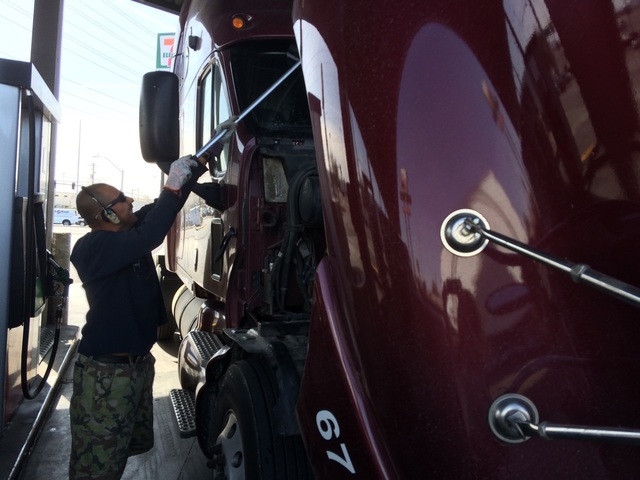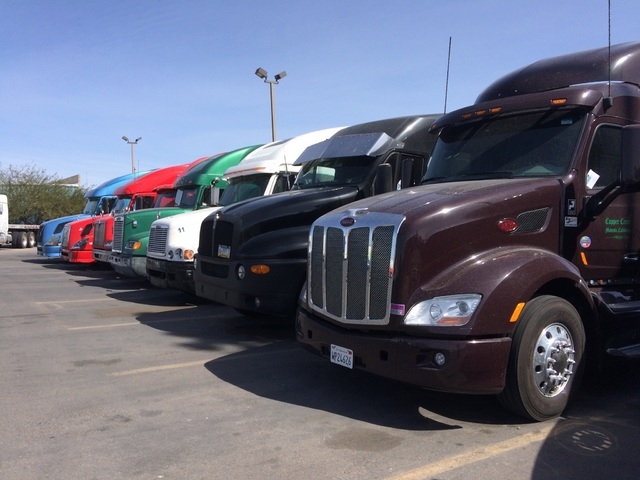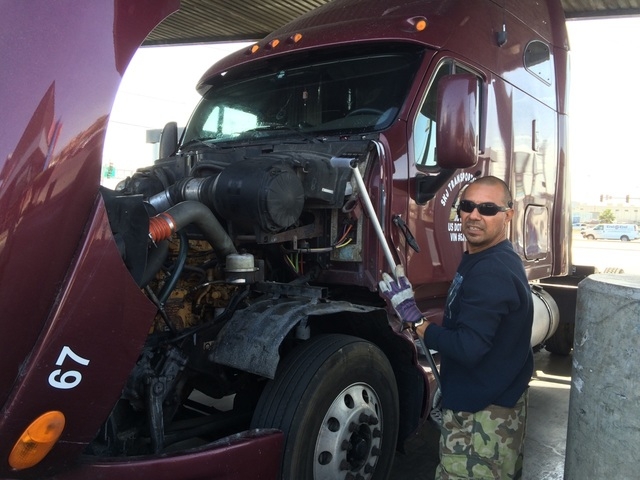Navigating around 18-wheelers requires extra care
Yes, it’s like following a wall. And, yes, they do crawl up hills.
But they have the same right to be on the highway as anyone else.
Tractor-trailers are essentially a moving warehouse on wheels and are classified as Class 3 vehicles. They can weigh 80,000 pounds when fully loaded. When big trucks are on the road, drivers of other vehicles should be aware of the 18-wheeler’s capabilities and limitations.
According to the National Highway Traffic Safety Administration, large trucks accounted for 3,964 fatalities nationwide in 2013. In Nevada, the Department of Transportation (NDOT) reported that between 2009-13, 371 people died, and 2,771 were seriously injured in collisions with big rigs.
Ken Kernitzki of northwest Las Vegas has been a truck driver for nearly 20 years. He began as a diesel mechanic before going for his license. He said he likes the travel.
Regular drivers “don’t understand what we’re doing; they’re not informed,” he said. “All they see is the truck in their way. It’s an obstacle, and that’s all they see.”
Kernitzki said the state should better educate regular drivers on the blind spots of big trucks and how they cannot stop as quickly.
Making a right-hand turn at an intersection is where he sees most of his near-miss moments. He estimated that 70 to 80 percent of drivers will try to take the right lane when he’s about to turn right.
“They’re unaware (of how much room is needed). They’re just trying to get around an obstacle,” he said. “All they see is something that’s slow and wasting their time, so they try to (squeeze around) us. But all they’re doing is increasing the danger.”
Statistics show that over 72 percent of accidents involving trucks are the fault of the other vehicle, according to NDOT. Paul Enos, CEO of the Nevada Trucking Association (NTA), said it’s closer to 80 percent.
“So, it’s the car (driver) not paying attention, rear-ending the truck or being in the blind spot of the truck,” he said.
He said some trucking companies are using technology with blind spot indicators and cameras but that it’s not yet widespread.
“They’re very expensive systems to employ, and they’re in their infancy now,” he said. “So, it’s really up to that truck driver to be aware of what’s going on around him with a pretty large blind spot area. So, what I tell people is, ‘If you can’t see the driver in his mirrors, then he can’t see you.’ ”
Enos said a good rule of thumb is to avoid passing on the right, and when passing on the left, go past the truck as quickly as possible.
“You don’t want to hang out in the blind spot area,” he said. “What I do is, I hang back and let the vehicle that’s in front of me get clear of that truck. Then I gun it. I pass that truck as fast as I can so I’m out of the blind spot.”
After passing the big rig, ensure that you can see the front of the truck in your rearview mirror before pulling in front of it.
While Southern Nevada does not see a lot of rain, it does have windy weather. Trucks have a huge surface area and are susceptible to gusts of wind.
No matter the weather, 18-wheelers require more time to stop than cars. Don’t cut in front of trucks — at freeway speeds, the NTA said it can take a fully loaded rig the length of three football fields to stop completely.
It’s not just metal-on-metal contact that motorists need to avoid — tire blowouts are common with big rigs. Be aware that large chunks of rubber can come flying off the truck, and the blowout usually results in swerving motions to get the rig under control.
Regarding headlights, the NTA said do not flash them at big rigs, as it is not a universal sign of anything. Some truck drivers think it’s a signal that it’s clear for them to change lanes in front of you, while some think it’s a warning that a cop is ahead.
Enos also advised motorists to not follow directly behind a big rig because if it has to brake hard, you won’t be able to react in time.
“If you’re right behind them, you can’t see what’s going on in front of that truck,” Enos said. “So, you need to be cognizant and give them their space.”
In Nevada, there are more than 49,000 people employed by the trucking industry, according to NDOT, with about 15,000 Class 3 truck drivers.
In 2012, the American Trucking Associations reported that more than 100,000 people — or nearly 275 per day — were injured in truck accidents.
Juan Santos has been a driver for 16 years and lives in the southeast valley. He said motorists often drive in his blind spot.
“All the time, I need to keep my eyes open and keep watch,” he said. “… Sometimes, people will (slice) across in front of my truck to change lanes. Or I’ll be going 60 mph, and they get on the freeway going 40.”
To reach Summerlin Area View reporter Jan Hogan, email her at jhogan@viewnews.com or call her at 702-387-2949.



















